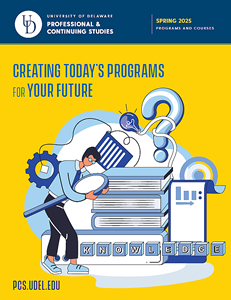
Successfully lead your company, group or team
 Combine leadership theory with real-world examples
Combine leadership theory with real-world examples- Receive a special bundled rate for all three courses
- Participate in online classes anywhere, anytime
- Discounts available
The Project Management Institute® (PMI®) requires all credential holders to earn PDUs in the three areas of the PMI Talent Triangle®: technical, leadership, and strategic and business management. The three online, self-paced courses in the Power Skills PDU Bundle provide practitioners with many of the PDUs needed to fulfill requirements in this important skill area. These three classes—Body Language for Leaders, Leading and Managing Change, and Leading Teams—award 12 PDUs in total, with 7.75 PDUs specifically targeted to leadership competency.
Each course contains real-world examples, videos, interactive games, assessments and focused instruction. Glossaries and search functions help students quickly and easily navigate through the course, and the “Ask the Expert” feature allows learners to pose course-related questions that are resolved within 24-48 hours by a specialist in the field.
Program details
![]() Power Skills PDU Bundle – 3 courses
Power Skills PDU Bundle – 3 courses
LOCATION: Online
ESTIMATED LENGTH: 12 hours
ACCESS TIME: 270 days
PRICE: $299, all materials included. Potential discounts available, including: Military, UD student/alum/employee, 2 or more (group).
1.2 CEUS | 12 HRCIs | 12 PDUS
Courses
Body Language for Leaders![]()
LOCATION: Online
ESTIMATED LENGTH: 3 hours
ACCESS TIME: 90 days
PRICE: Not available for individual sale, all materials included.
0.3 CEUS | 3 HRCIs | 3 PDUS
At the core of strong leadership is the ability to communicate effectively. But many leaders focus solely on their spoken words while ignoring the impact of their nonverbal cues, including facial expressions, hand gestures, body movements and eye gaze. By understanding the impact of body language, leaders can learn how to communicate in a way that builds and sustains positive relationships with employees, clients and business partners. This course provides leaders with tips for reading body language and using it to exude both strength and warmth. It also addresses gender stereotypes and cross-cultural body language and explores the role of body language in virtual communication.
LEARNER OUTCOMES
- Define leadership and identify the essential leadership skills.
- Explain how body language impacts leadership.
- Read basic body language cues.
- Use body language to exude warmth and empathy.
- Consider how to be an inclusive leader through active listening.
- Demonstrate charisma through body language.
- Use body language effectively when negotiating.
- Explore ways to use body language to debunk gender stereotypes.
- Identify body language norms across various cultures.
- Consider how to improve cross-cultural competencies.
- Manage body language during a video conference.
NOTES
- This course has an “Ask the Expert” feature, which submits your questions directly to an expert in the field you are studying. Questions are answered as quickly as possible and usually within 24 hours.
- Learners must achieve an average test score of at least 70% to meet the minimum successful completion requirement and qualify to receive International Association of Continuing Education and Training (IACET) CEUs. Learners will have three attempts at all graded assessments.
Leading and Managing Change![]()
LOCATION: Online
ESTIMATED LENGTH: 4 hours
ACCESS TIME: 90 days
PRICE: Not available for individual sale, all materials included.
0.4 CEUS | 4 HRCIs | 4 PDUS
Whether adopting new technology or adapting to a drastic shift in an organization’s core focus, change is a constant in any successful business. Managers play a fundamental role in successfully effecting changes across an organization, while humans, by nature, often resist change out of fear of the unknown. This introductory course addresses the key issues managers face in a dynamic environment. By understanding the steps in effecting change and how to overcome resistance, a manager can successfully lead change at various levels of an organization.
This course is based on D. Quinn Mills’ book, Leadership: How to Lead, How to Live, a text used at Harvard Business School. Excerpts of the book are made available via PDF download at no additional cost to students.
LEARNER OUTCOMES
- Discuss organizational change and the forms it can take.
- Describe Kotter’s Eight-Step Process recommended for implementing change successfully.
- Outline Lewin’s model of change and discuss its limitations.
- Identify the factors a leader or manager can employ to promote change.
- Outline the change initiative planning process.
- Explain the role of a leader in communicating change.
- Discuss methods to foster participation.
- Discuss the underpinnings of resistance to change and how to overcome them.
- Discuss other models of change management: ADKAR, GE CAP and Cisco Change Roadmap.
- Match change management models to specific scenarios.
- Understand strategic change and mastering a changing environment.
NOTES
- This course has an “Ask the Expert” feature, which submits your questions directly to an expert in the field you are studying. Questions are answered as quickly as possible and usually within 24 hours.
- Learners must achieve an average test score of at least 70% to meet the minimum successful completion requirement and qualify to receive International Association of Continuing Education and Training (IACET) CEUs. Learners will have three attempts at all graded assessments.
Leading Teams![]()
LOCATION: Online
ESTIMATED LENGTH: 5 hours
ACCESS TIME: 90 days
PRICE: Not available for individual sale, all materials included.
0.5 CEUs | 5 HRCIs | 5 PDUS
Leading a team through any task or project requires special skills, and an understanding of the team dynamic and politics. This introductory-level course for managers, or anyone interested in leading teams, addresses the key issues surrounding leadership in a team environment. Why is leadership important to team success? What is required of a team leader to lead their team effectively? This course considers how team leaders must account for the special and unique circumstances of working in a team, where responsibility, accountability, communication and leadership are shared.
This course is based on D. Quinn Mills’ book, Leadership: How to Lead, How to Live, a text used at Harvard Business School. Excerpts of the book are made available via PDF download at no additional cost to students.
LEARNER OUTCOMES
- List and identify the key characteristics and types of teams.
- Recognize the benefits and challenges of empowered teams that leaders need to be aware of.
- Identify differences in the primary and secondary roles filled by empowered teams and team leaders.
- Recognize the key sources of motivation for empowered teams.
- Explain Tuckman’s model of team development.
- Recognize the key qualities and skills of a team leader.
- State the value of using the “checklist for team leaders.”
- Recognize and apply suggested approaches for managing conflict in teams.
- Discuss the different approaches needed for leading virtual teams.
NOTES
- This course has an “Ask the Expert” feature, which submits your questions directly to an expert in the field you are studying. Questions are answered as quickly as possible and usually within 24 hours.
- Learners must achieve an average test score of at least 70% to meet the minimum successful completion requirement and qualify to receive International Association of Continuing Education and Training (IACET) CEUs. Learners will have three attempts at all graded assessments.


